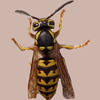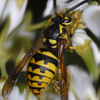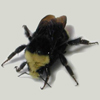Stinging Insects of Western Washington
Most people commonly refer to any flying insect with brown, black or yellow torso and stripes as a “bee”. However, the group of stinging insects that most often creates a nuisance for people are members of the wasp family Vespidae, part of the order Hymenoptera.
In Western Washington, the most common representatives of the family of North American Predatory Wasps (Vespidae) are the Yellow Jackets (genus Vespula).
Also very common are Bald Faced Hornets (genus Dolichovespula), and European Paper Wasps (genus Polistes). Black Jackets (also genus Vespula) are less prevalent, but can be encountered in the area.
Honey Bees and Bumble Bees on the other hand are both members of the bee family Apidae, which while also part of the order Hymenoptera, are only distantly related to wasps. Their general behavior and level of aggressiveness if provoked differs drastically from Vespidae representatives.
Depending on the specific situation, Wasps, Hornets, Yellow Jackets, Honey Bees and Bumble Bees nesting on your property can all become problematic and may require removal.
Each of them have different nesting habits, characteristics, and require different removal techniques. Dan The Bee Man is equipped to remove all of them without the use of any poison.
North American Predatory Wasps
Members have similar physical characteristics: They have a skinny to stout torso, are typically between ½ and 1 inch long, are mostly hairless (as opposed to fuzzy), have a clearly segmented body. They have long skinny wings, and if you manage to get a close enough look at their face, you can see large mandibles they use to manipulate their prey.
The most recognizable characteristic are the have black and bright yellow stripes, as opposed to the brown or honey colored stripes of honey bees. Bald Faced Hornets and Black Jackets are an exception, as their body is mostly black with white tips or stripes.
The group of Wasps that seem to cause the most trouble for Western Washington home owners are the Yellow Jackets.
Yellow Jackets
They break down into two major groups:
- Genus Vespula – primarily builds nests inside cavities or underground
- Genus Dolichovespula – primarily builds aerial, hanging nests attached to tree or shrub limbs or exterior walls
Genus Vespula is represented in Western Washington by these members:
Common Yellow Jacket – Vespula Vulgaris

- Scavenges, is a picnic pest
- Nests have a characteristic red/tan/brown color, are predominately located inside wall cavities, in logs, rotting stumps, railroad ties, landscape timber
- Stings when disturbed while scavenging or if nest is threatened
- May sting unprovoked
German Yellow Jacket (sometimes also called German Wasp) – Vespula Germanica

- Scavenges, is a picnic pest
- Nests in retaining walls, inside wall cavities, and underground
- Stings when disturbed while scavenging or if nest is threatened
- May sting unprovoked
Western Yellow Jacket – Vespula Pensylvanica

- Scavenges, is a picnic pest, can be very aggressive
- Nests primarily underground, in abandoned mammal burrows
- Stings when disturbed while scavenging or when nest is disturbed
- May “chase” humans and sting unprovoked
Genus Dolichovespula has two representatives in Western Washington:
Aerial Yellow Jacket – Dolichovespula Arenaria

- Not typically a picnic pest, not very aggressive
- Nests are gray in color, built above ground, commonly attached to structures, or hanging in trees, can become basketball sized
- Stings when nest is disturbed
Bald Faced Hornets – Dolichovespula Maculata

- Quite large and plump, but not typically aggressive if encountered away from the nest
- Not a picnic pest, feeds on flies and other yellow jackets, also a honey bee pest
- Nests gray to brown in color, sometimes “fuzzy” or “shaggy” in appearance, basketball sized or larger. Nests usually appear high up in trees, but sometimes in bushes or at lower levels. Seem to have a preference for rhododendron bushes and trees.
- Fiercely defends nest, known to go for human face when stinging
The Bald Faced Hornet is not actually a member of the Genus Vespa, which is more commonly referred to as a Hornet around the world. It is more closely related to the Yellow Jacket.
Western Washington is also home to a representative of the Paper Wasps – Genus Polistinae
European Paper Wasp – Polistes dominulus

- Not a picnic pest, not very aggressive
- Easily identified visually by its distinctive long dangling legs and clearly segmented lower abdomen.
- Builds small, often uncovered paper nests, commonly attached under eves or overhangs
- Stings when disturbed.
Honey Bees & Bumble Bees
Only distantly related to the Yellow Jackets are two other groups of stinging insects at home in Western Washington: The Honey Bee (Genus Apis) and the Bumble Bee (Genus Bombus). Both have countless varieties, though the general descriptions of both physical appearance and behavior are very similar between the different varieties.
European Honey Bee – Apis Mellifera

- Not a picnic pest, not very aggressive
- Can sting humans only once, a barbed stinger gets stuck in human skin
- Will only sting as a last resort, Honey Bee dies after stinging
- Bee venom is powerful, can hurt a lot
Yellow-Faced Bumble Bee – Bombus Vosnesenskii

- Most often mistaken for a hornet due to its mostly black body
- Not a picnic pest, not very aggressive
- Nests are often found in piles of leaves or compost piles
- Can sting multiple times if sufficiently annoyed
Tricolored Bumble Bee – Bombus Ternarius

- Not a picnic pest
- Nests often found in abandoned mouse burrows
- Can be somewhat aggressive if nest is disturbed
- Can sting multiple times if sufficiently annoyed
Orange-Rumped Bumble Bee – Bombus Melanopygus

- Not a picnic pest
- Nests are often found in bird houses
- Can be somewhat aggressive if nest is disturbed
- Can sting multiple times if sufficiently annoyed


